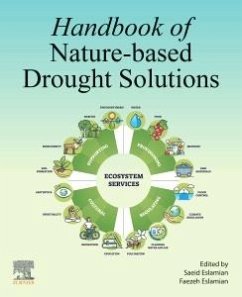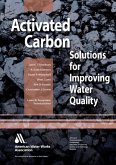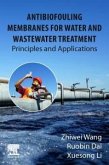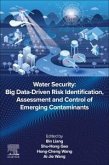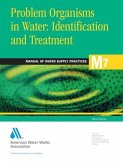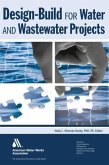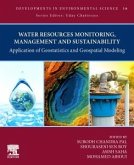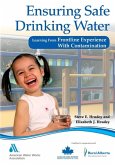Handbook of Nature-Based Drought Solutions
Herausgeber: Eslamian, Saeid; Eslamian, Faezeh
Handbook of Nature-Based Drought Solutions
Herausgeber: Eslamian, Saeid; Eslamian, Faezeh
- Broschiertes Buch
- Merkliste
- Auf die Merkliste
- Bewerten Bewerten
- Teilen
- Produkt teilen
- Produkterinnerung
- Produkterinnerung
Handbook of Nature-Based Drought Solutions covers the latest research on successful, sustainable solutions for the efficient water resources management to overcome the drought and water scarcity problems. The book centers around the realms of drought modeling green infrastructure planning, and the utilization of remote sensing to evaluate, dissect, and oversee drought occurrences. It delves into subjects such as risk mitigation, strategic planning, policy considerations, and the ecological restoration of degraded lands after drought. The use of case studies and novel methodologies including…mehr
Andere Kunden interessierten sich auch für
![Activated Carbon: Solutions for Improving Water Quality Activated Carbon: Solutions for Improving Water Quality]() Activated Carbon: Solutions for Improving Water Quality221,99 €
Activated Carbon: Solutions for Improving Water Quality221,99 €![Antibiofouling Membranes for Water and Wastewater Treatment Antibiofouling Membranes for Water and Wastewater Treatment]() Zhiwei WangAntibiofouling Membranes for Water and Wastewater Treatment236,99 €
Zhiwei WangAntibiofouling Membranes for Water and Wastewater Treatment236,99 €![Water Security: Big Data-Driven Risk Identification, Assessment and Control of Emerging Contaminants Water Security: Big Data-Driven Risk Identification, Assessment and Control of Emerging Contaminants]() Water Security: Big Data-Driven Risk Identification, Assessment and Control of Emerging Contaminants186,99 €
Water Security: Big Data-Driven Risk Identification, Assessment and Control of Emerging Contaminants186,99 €![M7 Problem Organisms in Water: Identification and Treatment, Third Edition M7 Problem Organisms in Water: Identification and Treatment, Third Edition]() AwwaM7 Problem Organisms in Water: Identification and Treatment, Third Edition187,99 €
AwwaM7 Problem Organisms in Water: Identification and Treatment, Third Edition187,99 €![Design-Build for Water and Wastewater Projects Design-Build for Water and Wastewater Projects]() Design-Build for Water and Wastewater Projects199,99 €
Design-Build for Water and Wastewater Projects199,99 €![Water Resources Monitoring, Management, and Sustainability Water Resources Monitoring, Management, and Sustainability]() Water Resources Monitoring, Management, and Sustainability155,99 €
Water Resources Monitoring, Management, and Sustainability155,99 €![Ensuring Safe Drinking Water: Learning from Frontline Experience with Contamination Ensuring Safe Drinking Water: Learning from Frontline Experience with Contamination]() Elizabeth J Hrudey Steve E HrudeyEnsuring Safe Drinking Water: Learning from Frontline Experience with Contamination87,99 €
Elizabeth J Hrudey Steve E HrudeyEnsuring Safe Drinking Water: Learning from Frontline Experience with Contamination87,99 €-
-
-
Handbook of Nature-Based Drought Solutions covers the latest research on successful, sustainable solutions for the efficient water resources management to overcome the drought and water scarcity problems. The book centers around the realms of drought modeling green infrastructure planning, and the utilization of remote sensing to evaluate, dissect, and oversee drought occurrences. It delves into subjects such as risk mitigation, strategic planning, policy considerations, and the ecological restoration of degraded lands after drought. The use of case studies and novel methodologies including soft computing technique application will help the reader gain a deeper knowledge in understanding, predicting, and mitigating hydrometeorological hazards.
Hinweis: Dieser Artikel kann nur an eine deutsche Lieferadresse ausgeliefert werden.
Hinweis: Dieser Artikel kann nur an eine deutsche Lieferadresse ausgeliefert werden.
Produktdetails
- Produktdetails
- Verlag: Elsevier Science
- Seitenzahl: 800
- Erscheinungstermin: 1. Mai 2025
- Englisch
- ISBN-13: 9780443299933
- ISBN-10: 0443299935
- Artikelnr.: 70983485
- Herstellerkennzeichnung
- Libri GmbH
- Europaallee 1
- 36244 Bad Hersfeld
- 06621 890
- Verlag: Elsevier Science
- Seitenzahl: 800
- Erscheinungstermin: 1. Mai 2025
- Englisch
- ISBN-13: 9780443299933
- ISBN-10: 0443299935
- Artikelnr.: 70983485
- Herstellerkennzeichnung
- Libri GmbH
- Europaallee 1
- 36244 Bad Hersfeld
- 06621 890
Part 1-Introduction
1. An Introduction to Drought Nature-Based Solutions
2. Reimagining the Indoor Water Footprint
Part 2-Building Social Capacity
3. Building Social Capital and Community Resilience
4. Water Governance Reform and Social Marketing Campaigns
5. Developing Social Capital and Enhancing Community Resilience
Part 3-Climate-Smart and Dry Farming Techniques
6. Climate[1]Smart and Dry Farming Techniques
7. Climate-Smart and Dry Farming Techniques
8. Climate[1]Smart and Dry Farming Techniques
Part 4- Agricultural Water Efficiency Improvement
9. Developing Floating Gardens to Improve Water Efficiency I
10. Developing Floating Gardens to Improve Water Efficiency II
11. Deciduous Trees to Reduce Energy Needs and Evapotranspiration
12. Genetically Modified Crops with Enhanced Drought Tolerance
13. Micro-irrigation and Sensor-based Irrigation Controls
14. Treating and Reusing Agricultural Drainage Water
Part 5-Drought Early Action Plan
15. Drought Images in the Social Sciences School Textbooks (Primary
Education, Spain)
16. Drought Early Action Plans[1]
Part 6-Drought Resilient Urban and Regional Planning
17. Drought Resilient Urban and Regional Planning I
18. Drought Resilient Urban and Regional Planning II
19. Drought Resilient Urban and Regional Planning III
20. Drought Resilient Urban and Regional Planning IV
21. Drought Resilient Urban and Regional Planning,V
22. Drought Risk Management and Contingency Planning
Part 7-Ecological Restoration of Degraded Lands After Drought
23. Ecological Restoration of Degraded Lands After Drought I
24. Ecological Restoration of Degraded Lands After Drought II
25. Ecological Restoration of Degraded Lands After Drought III
Part 8-Green Infrastructure Planning
26. Green Infrastructure Planning I
27. Green Infrastructure Planning II
28. Green Infrastructure Planning III
Part 9-Integrated Urban Water Management
29. Integrated Urban Water Management I
30. Integrated Urban Water Management II
31. Integrated Urban Water Management III
32. Integrated Flood and Drought Management Planning
Part 10- River Basin Management and Conservation
33. Permeable Pavements and Gabion Baskets for Rainwater Infiltration
34. Prescribed Burning to Reduce Wildfire Risk and Severity
35. Rainwater Harvesting by Ridge and Furrow Techniques
36. Case Studies of Grassland/Savanna/Veldt Ecosystems in Africa
37. Community Based Watershed Management in India
38. Community-based Watershed Management in Africa
Part 11-Soft-Computing Technique Application
39. Remotely Sensed Soil Moisture Monitoring
40. Temperature Increase Prediction using Soft Computing Techniques for a
Drought-Effected Region
41. Hydrological and Agricultural Drought Forecasting Based on ANFIS
Hybridized with Various Nature-Inspired Optimization Algorithms
42. Climate Change Impact on drought Intensity and Period
Part 12- Weather-based Modification Examples
43. The Social Impacts of Fog Catchers in Chile
44. Fog Harvesting and Dew Collection
45. Indigenous Weather Forecasting and Risk Communication[1]
Part 13-Transboundary Mega-basin Management
46. Transboundary Mega-basin Management I
47. Transboundary Mega-basin Management II
1. An Introduction to Drought Nature-Based Solutions
2. Reimagining the Indoor Water Footprint
Part 2-Building Social Capacity
3. Building Social Capital and Community Resilience
4. Water Governance Reform and Social Marketing Campaigns
5. Developing Social Capital and Enhancing Community Resilience
Part 3-Climate-Smart and Dry Farming Techniques
6. Climate[1]Smart and Dry Farming Techniques
7. Climate-Smart and Dry Farming Techniques
8. Climate[1]Smart and Dry Farming Techniques
Part 4- Agricultural Water Efficiency Improvement
9. Developing Floating Gardens to Improve Water Efficiency I
10. Developing Floating Gardens to Improve Water Efficiency II
11. Deciduous Trees to Reduce Energy Needs and Evapotranspiration
12. Genetically Modified Crops with Enhanced Drought Tolerance
13. Micro-irrigation and Sensor-based Irrigation Controls
14. Treating and Reusing Agricultural Drainage Water
Part 5-Drought Early Action Plan
15. Drought Images in the Social Sciences School Textbooks (Primary
Education, Spain)
16. Drought Early Action Plans[1]
Part 6-Drought Resilient Urban and Regional Planning
17. Drought Resilient Urban and Regional Planning I
18. Drought Resilient Urban and Regional Planning II
19. Drought Resilient Urban and Regional Planning III
20. Drought Resilient Urban and Regional Planning IV
21. Drought Resilient Urban and Regional Planning,V
22. Drought Risk Management and Contingency Planning
Part 7-Ecological Restoration of Degraded Lands After Drought
23. Ecological Restoration of Degraded Lands After Drought I
24. Ecological Restoration of Degraded Lands After Drought II
25. Ecological Restoration of Degraded Lands After Drought III
Part 8-Green Infrastructure Planning
26. Green Infrastructure Planning I
27. Green Infrastructure Planning II
28. Green Infrastructure Planning III
Part 9-Integrated Urban Water Management
29. Integrated Urban Water Management I
30. Integrated Urban Water Management II
31. Integrated Urban Water Management III
32. Integrated Flood and Drought Management Planning
Part 10- River Basin Management and Conservation
33. Permeable Pavements and Gabion Baskets for Rainwater Infiltration
34. Prescribed Burning to Reduce Wildfire Risk and Severity
35. Rainwater Harvesting by Ridge and Furrow Techniques
36. Case Studies of Grassland/Savanna/Veldt Ecosystems in Africa
37. Community Based Watershed Management in India
38. Community-based Watershed Management in Africa
Part 11-Soft-Computing Technique Application
39. Remotely Sensed Soil Moisture Monitoring
40. Temperature Increase Prediction using Soft Computing Techniques for a
Drought-Effected Region
41. Hydrological and Agricultural Drought Forecasting Based on ANFIS
Hybridized with Various Nature-Inspired Optimization Algorithms
42. Climate Change Impact on drought Intensity and Period
Part 12- Weather-based Modification Examples
43. The Social Impacts of Fog Catchers in Chile
44. Fog Harvesting and Dew Collection
45. Indigenous Weather Forecasting and Risk Communication[1]
Part 13-Transboundary Mega-basin Management
46. Transboundary Mega-basin Management I
47. Transboundary Mega-basin Management II
Part 1-Introduction
1. An Introduction to Drought Nature-Based Solutions
2. Reimagining the Indoor Water Footprint
Part 2-Building Social Capacity
3. Building Social Capital and Community Resilience
4. Water Governance Reform and Social Marketing Campaigns
5. Developing Social Capital and Enhancing Community Resilience
Part 3-Climate-Smart and Dry Farming Techniques
6. Climate[1]Smart and Dry Farming Techniques
7. Climate-Smart and Dry Farming Techniques
8. Climate[1]Smart and Dry Farming Techniques
Part 4- Agricultural Water Efficiency Improvement
9. Developing Floating Gardens to Improve Water Efficiency I
10. Developing Floating Gardens to Improve Water Efficiency II
11. Deciduous Trees to Reduce Energy Needs and Evapotranspiration
12. Genetically Modified Crops with Enhanced Drought Tolerance
13. Micro-irrigation and Sensor-based Irrigation Controls
14. Treating and Reusing Agricultural Drainage Water
Part 5-Drought Early Action Plan
15. Drought Images in the Social Sciences School Textbooks (Primary
Education, Spain)
16. Drought Early Action Plans[1]
Part 6-Drought Resilient Urban and Regional Planning
17. Drought Resilient Urban and Regional Planning I
18. Drought Resilient Urban and Regional Planning II
19. Drought Resilient Urban and Regional Planning III
20. Drought Resilient Urban and Regional Planning IV
21. Drought Resilient Urban and Regional Planning,V
22. Drought Risk Management and Contingency Planning
Part 7-Ecological Restoration of Degraded Lands After Drought
23. Ecological Restoration of Degraded Lands After Drought I
24. Ecological Restoration of Degraded Lands After Drought II
25. Ecological Restoration of Degraded Lands After Drought III
Part 8-Green Infrastructure Planning
26. Green Infrastructure Planning I
27. Green Infrastructure Planning II
28. Green Infrastructure Planning III
Part 9-Integrated Urban Water Management
29. Integrated Urban Water Management I
30. Integrated Urban Water Management II
31. Integrated Urban Water Management III
32. Integrated Flood and Drought Management Planning
Part 10- River Basin Management and Conservation
33. Permeable Pavements and Gabion Baskets for Rainwater Infiltration
34. Prescribed Burning to Reduce Wildfire Risk and Severity
35. Rainwater Harvesting by Ridge and Furrow Techniques
36. Case Studies of Grassland/Savanna/Veldt Ecosystems in Africa
37. Community Based Watershed Management in India
38. Community-based Watershed Management in Africa
Part 11-Soft-Computing Technique Application
39. Remotely Sensed Soil Moisture Monitoring
40. Temperature Increase Prediction using Soft Computing Techniques for a
Drought-Effected Region
41. Hydrological and Agricultural Drought Forecasting Based on ANFIS
Hybridized with Various Nature-Inspired Optimization Algorithms
42. Climate Change Impact on drought Intensity and Period
Part 12- Weather-based Modification Examples
43. The Social Impacts of Fog Catchers in Chile
44. Fog Harvesting and Dew Collection
45. Indigenous Weather Forecasting and Risk Communication[1]
Part 13-Transboundary Mega-basin Management
46. Transboundary Mega-basin Management I
47. Transboundary Mega-basin Management II
1. An Introduction to Drought Nature-Based Solutions
2. Reimagining the Indoor Water Footprint
Part 2-Building Social Capacity
3. Building Social Capital and Community Resilience
4. Water Governance Reform and Social Marketing Campaigns
5. Developing Social Capital and Enhancing Community Resilience
Part 3-Climate-Smart and Dry Farming Techniques
6. Climate[1]Smart and Dry Farming Techniques
7. Climate-Smart and Dry Farming Techniques
8. Climate[1]Smart and Dry Farming Techniques
Part 4- Agricultural Water Efficiency Improvement
9. Developing Floating Gardens to Improve Water Efficiency I
10. Developing Floating Gardens to Improve Water Efficiency II
11. Deciduous Trees to Reduce Energy Needs and Evapotranspiration
12. Genetically Modified Crops with Enhanced Drought Tolerance
13. Micro-irrigation and Sensor-based Irrigation Controls
14. Treating and Reusing Agricultural Drainage Water
Part 5-Drought Early Action Plan
15. Drought Images in the Social Sciences School Textbooks (Primary
Education, Spain)
16. Drought Early Action Plans[1]
Part 6-Drought Resilient Urban and Regional Planning
17. Drought Resilient Urban and Regional Planning I
18. Drought Resilient Urban and Regional Planning II
19. Drought Resilient Urban and Regional Planning III
20. Drought Resilient Urban and Regional Planning IV
21. Drought Resilient Urban and Regional Planning,V
22. Drought Risk Management and Contingency Planning
Part 7-Ecological Restoration of Degraded Lands After Drought
23. Ecological Restoration of Degraded Lands After Drought I
24. Ecological Restoration of Degraded Lands After Drought II
25. Ecological Restoration of Degraded Lands After Drought III
Part 8-Green Infrastructure Planning
26. Green Infrastructure Planning I
27. Green Infrastructure Planning II
28. Green Infrastructure Planning III
Part 9-Integrated Urban Water Management
29. Integrated Urban Water Management I
30. Integrated Urban Water Management II
31. Integrated Urban Water Management III
32. Integrated Flood and Drought Management Planning
Part 10- River Basin Management and Conservation
33. Permeable Pavements and Gabion Baskets for Rainwater Infiltration
34. Prescribed Burning to Reduce Wildfire Risk and Severity
35. Rainwater Harvesting by Ridge and Furrow Techniques
36. Case Studies of Grassland/Savanna/Veldt Ecosystems in Africa
37. Community Based Watershed Management in India
38. Community-based Watershed Management in Africa
Part 11-Soft-Computing Technique Application
39. Remotely Sensed Soil Moisture Monitoring
40. Temperature Increase Prediction using Soft Computing Techniques for a
Drought-Effected Region
41. Hydrological and Agricultural Drought Forecasting Based on ANFIS
Hybridized with Various Nature-Inspired Optimization Algorithms
42. Climate Change Impact on drought Intensity and Period
Part 12- Weather-based Modification Examples
43. The Social Impacts of Fog Catchers in Chile
44. Fog Harvesting and Dew Collection
45. Indigenous Weather Forecasting and Risk Communication[1]
Part 13-Transboundary Mega-basin Management
46. Transboundary Mega-basin Management I
47. Transboundary Mega-basin Management II

